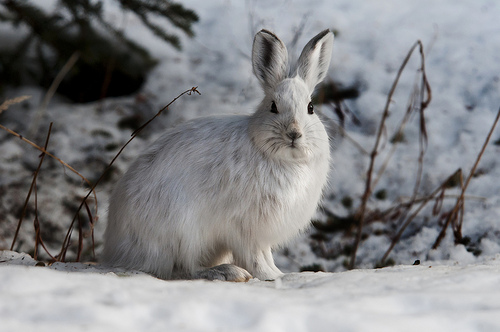Snowshoe hares do have ‘snow shoes’.
- Snowshoe hares are mostly nocturnal mammals native to forestry areas of northern parts of North America.
- ‘Snowshoe hares’ are also known as ‘snowshoe rabbits’ and ‘varying hares’ and have smaller ears than most other hares.
- The snowshoe hare’s scientific name is Lepus americanus and it comes from the family Leporidae, the family of rabbits and hares.
- The name ‘snowshoe hare’ comes from the animal’s very large and furry back feet that allows the hare to move across snow more easily, and they can reach up to speeds of 43.5 km/hr (27 miles per hour).
- Snowshoe hares have brown coloured fur during summer, that changes to white in winter, with the change occurring over a 10 week period.
Snowshoe hare during winter
Image courtesy of Denali National Park and Preserve/Flickr
- A snowshoe hare’s diet mainly consists of vegetation, with leaves and grass eaten during summer and bark, twigs and buds eaten during winter.
- Snowshoe hares generally have litters of 2 to 4 young, known as leverets, up to 4 times a year.
- Snowshoe hares are preyed on by dogs, cats, large birds, lynxes, foxes and weasels, among others.
- Snowshoe hares grow to be 41 to 52 centimetres (16 to 20 inches) in length and range from 0.9 to 1.8 kilograms (2 to 4 pounds) in weight.
- Snowshoe hares have a relatively short lifespan, typically a year, due to being a main food source for a number of predators, but they can grow to be 5 years old.
Bibliography:
Shefferly N, Lepus americanus, 2007, Animal Diversity Web, http://animaldiversity.ummz.umich.edu/accounts/Lepus_americanus/
Snowshoe hare, 2014, National Geographic, http://animals.nationalgeographic.com.au/animals/mammals/snowshoe-hare/
Snowshoe hare, 2014, Wikipedia, http://en.wikipedia.org/wiki/Snowshoe_hare






